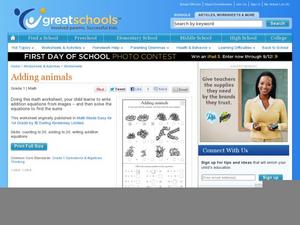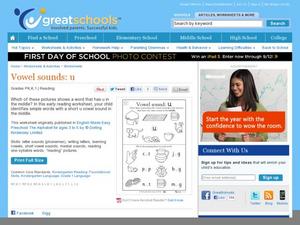DK Publishing
Counting Caterpillars
These caterpillars each have a number sequence printed on their segmented bodies, but some numbers are missing! Look at the completed caterpillars as an example, asking kids to notice a possible pattern. They should observe that the...
Curated OER
g and q
Give printing practice a creative spin as young writers become familiar with the lowercase letters g and q. They trace each letter four times before printing a set on their own in the space provided. The fun twist is that...
Curated OER
Count How Many
How many now? Math beginners will benefit from this introduction to addition which doesn't even include addition symbols. They read number sentences in word form; however the numbers are in numeric form (for example, "1 and 2 more...
Curated OER
Counting Out Loud
These number sequences are quite fun to look at! Beginning counters complete six of them as they say and write in the numbers. They count only by 1s, however some of these move from greatest to least. The highest number here is 20. Once...
Curated OER
Adding Animals
Writing equations from images helps young mathematicians grasp addition, especially when they get to look at cute animals as they do it. There are six number sentences here, each illustrated with a set of animals corresponding to...
Curated OER
Writing Numbers
How many letters? Budding counters determine and record the number of letters in five messages trailing behind planes. The write down both the numeral and the word form; the highest number here is 19. Next, pupils fill in two blank...
Curated OER
1 Less or 1 More
Complete these images with values one less and one more; young mathematicians fill in bunches of flowers, starting at a middle number and working their way to the right by addition and to the left by subtraction. For each flower they...
Curated OER
Vowel Sound: u
Which of these have /u/ as a middle sound? There are images of seven CVC words surrounding the letter u here, and scholars draw lines from the letter to words with the same middle phoneme. Be sure they know what these images are...
Curated OER
v and w
Have fun with lowercase letters v and w as scholars get some printing practice. They use dotted lines and arrows to get some printing practice before writing a set on their own for each letter. Then, they complete an image of...
Curated OER
Writing Letters: c and o
How can you incorporate drawing a dinosaur with printing practice? Here's how! Budding printers trace and write lowercase letters c and o, following guidelines to trace one set before trying another on their own. Then,...
Curated OER
i and t
As emerging printers learn the letters of the alphabet, make it more fun by giving them creative worksheets like this one focused on the lowercase letters i and t. They follow arrows to trace each letter several times...
Curated OER
Creating Letter-shape Patterns #2
Before learners become writers they need to feel comfortable moving a pencil from left to right in various patterns. Use these exercises to give budding printers some fine motor practice. They complete three patterns by tracing a dotted...
Curated OER
u and y
Who knew the lowercase letters u and y could be so artistic? Learners get creative as they trace and print these letters, working from left to right. Each letter has examples, both traceable and solid. Learners follow the...
Curated OER
x and z
Move to the end of the alphabet with some kid-friendly practice focused on the letters x and z that will inspire your scholars' artistic side. They connect the dots to trace the lowercase letters before copying them in the space...
Curated OER
r and n
Here is some kid-friendly practice with the letters r and n that will ignite your scholars' artistic sides. They connect the dots to trace the lowercase letters before copying them in the space provided. There are two...
Curated OER
O
As part of a series of alphabet worksheets, learners focus on the letters p and o. They begin by tracing the lowercase letters, using the space to print a few on their own. Next, scholars connect the letter to images that begin...
Curated OER
Write the Word
Combine printing practice, shape recognition, and the color red with your kindergartners. They start by tracing the word red and writing it once or twice on their own. Then, they examine an image of flowers and color all the...
Curated OER
Match the Rhymes
Focus on the short u sound in this rhyme instructional activity for emergent readers. Learners examine images surrounding a jug, drawing lines to connect it to those that rhyme (bug, rug, mug). Then, they practice their printing by...
Curated OER
Creating Letter-shape Patterns
Help your budding writers become familiar with letter shapes using a pattern activity. They examine three patterns, tracing a dotted line to continue them to the end of the page. For each, they also draw the pattern freehand below. This...
Curated OER
Find the Rhyme
Which of these objects rhymes? There are four starter pictures here, each heading rows of three objects. Learners determine and circle the row object that rhymes with the first one. Then, they connect two of the CVC words with printing...
Curated OER
Practicing Letters g and h
Which of these pictures begins with this sound? Learners focus on letters g and h in this alphabet practice instructional activity. They trace and print each letter and add them to an incomplete alphabet. Then, they...
Curated OER
Practicing Letters y and z
Get familiar with the end of the alphabet using this y and z learning exercise. Learners trace and print each letter and add them to an incomplete alphabet. Then, they draw lines connecting the letter to objects that...
Curated OER
Find the Rhyme
Which one rhymes? There are four starting objects here, each heading a row of three objects. Learners identify the objects and their vowel sounds to determine which one rhymes with the first object. All these rhyming words involve the...
Curated OER
Odd One Out
Which word doesn't rhyme? As they practice vowel-sound recognition, scholars examine rows of familiar objects to determine which object doesn't rhyme. There are four rows here, each with a beginning image and three subsequent images....

























